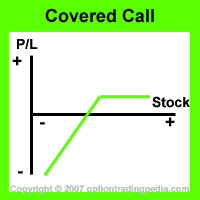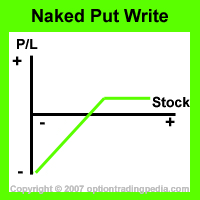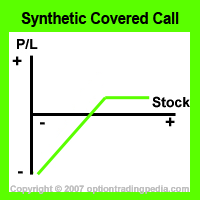How Does The Synthetic Covered Call Work in Options Trading?
Synthetic Covered Call - Introduction
Synthetic positions in options trading is the use of options and/or stocks in order to produce positions that are equivalent in payoff characteristics as another totally different position. So, is there a way to produce the payoff characteristics of the all time favorite options strategy, the Covered Call, without buying the underlying stock in the first place? Yes there is and the Synthetic Covered Call is the answer.
So, what is the synthetic covered call made up of? The answer is incredibly simple, a single Naked Put Write.
|
|
Payoff Characteristics of a Covered Call
To understand why a naked put write creates a synthetic covered call, we need to first explore the payoff characteristics of a Covered Call in the first place. A Covered Call consists of buying the underlying stock and writing an out of the money or at the money call option. The naked put write is a synthetic covered call for the at the money covered call.
Buying the underlying stock returns a profit when the stock moves up, a loss when the stock moves down and breakeven when the stock remains stagnant. By writing at the money call options against this stock position, the value of the position would no longer increase as the value of the call options increase dollar for dollar with the increase in the stock price. That places a ceiling on the topside profit. However, due to premium earned by writing the call options, the position actually returns a profit even if the stock remains stagnant. It also grants limited downside protection in the amount of premium gained by writing the call options, hence shifting the breakeven point of the position leftwards, resulting in a risk graph (payoff characteristic) below:

How Does Naked Put Write Simulate The Payoff of a Covered Call?
The naked put write is a simple options trading strategy involving writing put options. When you write a put option, you are giving someone else the right to profit when the underlying stock moves downwards. It is an unlimited loss potential options position. This means that as long as the underlying stock continues to fall, you will continue to make a progressively bigger loss. If the stock remains stagnant or moves upwards instead, you stand to profit from the extrinsic value of the put options that are written. Plotting out the payoff diagram of a naked put write gives us:

Compare the risk graph of the Naked Put Write with that of the Covered Call above. Do you see that they are exactly the same? This is why naked put writes are synthetic covered calls.
|
Synthetic Covered Call Example
Assuming QQQQ is trading at $45 and its $45 strike price call options are asking $1.25 and its $45 strike price put options are asking $1.25 as well. At the money call and put options are of the same price when put call parity is strong. Lets compare the actual profit and loss of the At The Money Covered Call and the Synthetic Covered Call to see how they are exactly the same as well. Covered Call Profit on Stock = $5 Loss on Call = $5 - $1.25 = $3.75 Net Profit = $1.25 Synthetic Covered Call Profit on put options as it expires out of the money = $1.25 Covered Call Loss on Stock = $5 Profit on Call as it expires out of the money = $1.25 Net Loss = $3.75 Synthetic Covered Call Loss on put options = $5 - $1.25 = $3.75 |
Do you see above that when put call parity is strong and the price of at the money call and put options are the same, not only will the synthetic covered call produce the same payoff characteristics, it will also generate the same amount of profit or loss in actual dollars as if you have executed an actual Covered Call! That is one of the main reasons why synthetic positions are used so widely in options trading.
|
|
The price of similiar call and put options are only the same in options trading when put call parity is strong. However, this is also rarely the case and there might be a significant difference between the price of similiar call and put options due to difference in demand. As such, you may need to compare the returns between the actual and synthetic covered call due to these difference in prices before deciding which makes the best return on investment. |
Why use Synthetic Covered Calls?
The main reason for the use of synthetic covered calls in options trading is cost saving. Synthetic Covered Calls save on upfront investment by not needing to buy the underlying stock and save on commissions by having only one leg and not two legs like in an actual Covered Call. Lets compare the costs of using an actual covered call and a synthetic covered call:
|
Synthetic Covered Call Example
Assuming QQQQ is trading at $45 and its $45 strike price call options are asking $1.25 and its $45 strike price put options are asking $1.25 as well. At the money call and put options are of the same price when put call parity is strong. Assuming round trip commission is $15 per leg. Cost of Actual Covered Call Buy 100 shares of QQQQ = $45 x 100 = $4,500 Sell 1 contract of Call Options = $1.25 x 100 = $125 Round trip commissions = $15 x 2 = $30 Total investment = $30 + ($4500 - $125) = $4,405 Cost of Synthetic Covered Call Sell 1 contract of put options = $1.25 x 100 = $1.25 credit Round trip commissions = $15 Total investment = $125 - $15 = $110 net credit |
In the example above, the difference between the cost of an actual covered call versus its synthetic equal is the difference between paying $4,405 or RECEIVING $110! That's a vast difference in upfront investment in options trading!
Problems with Synthetic Covered Call?
If a synthetic covered call is so good, why is anyone still doing the actual covered call?
Well, everything is fair in options trading and no options trading strategy have an absolute advantage over another. There are two main reasons why the actual covered call is still more popular amongst beginner options traders.
First and foremost is the margin requirement in writing uncovered options in options trading. Yes, most options brokers require margin as much as $100,000 cash in an account before it is allowed to write a single options contract. The margin requirement alone has shut the synthetic covered call out of the realm of possibilities for small retail traders. In fact, most options brokers would not even allow a new account with no prior options trading experience to write uncovered options in the first place.
Secondly, most beginner options traders were once stock traders or stock investors and already owns some shares in their accounts. It is a simple matter of writing call options against these existing stocks to transform them into covered calls.
Another problem with Synthetic Covered Calls is the fact that you do not gain from dividends if the underlying stock pays a dividend.
How To Use Synthetic Covered Call?
Establishing a Synthetic Covered Call is extremely simple. All you have to do is to write (sell to open) as many contracts of at the money put options as you would have call options in an actual covered call.
Sell ATM Put
Profit Potential of Synthetic Covered Call :
The Synthetic Covered Call's maximum profit occurs when the underlying stock closes at or above the strike price of the put options written.
Profit Calculation of Synthetic Covered Call:
Maximum Profit = Extrinsic Value of Put Options Written
Risk / Reward of Synthetic Covered Call:
Upside Maximum Profit: Limited
Maximum Loss: Unlimited
Happens when price of stock drops below strike price of short put options.
Losing Point of Synthetic Covered Call:
The losing point of the Synthetic Covered Call is the price below which the position starts to make its loss.
Losing Point = Strike Price - Extrinsic Value of Put Options
|
Synthetic Covered Call Example
Assuming QQQQ is trading at $45 and its $45 strike price put options are asking $1.25. Losing Point = $45 - $1.25 = $43.75 |
Advantages Of Synthetic Covered Call:
:: Much lower cost than actual Covered Call
:: Returns the same profit and loss profile of an actual Covered Call
Disadvantages Of Synthetic Covered Call:
:: Margin is required
Alternate Actions for Synthetic Covered Calls Before Expiration :
1. If the price of the stock drops to the strike price of the short put options before expiration and is assessed that the stock could continue to drop, you could transform the synthetic covered call position into a Bull Put Spread by buying as many out of the money put options as you have short put options. This transforms the unlimited loss nature of the synthetic covered call into a position with loss limited by the strike price of the long put options.
2. If the price of the stock is expected to sustain a bear trend for a significant period of time, you can transform the synthetic covered call into a Short Bear Ratio Spread by buying twice as many out of the money put options as the short put options. The Short Bear Ratio Spread has unlimited profit potential to downside. Such transformations can be automatically performed without monitoring using Contingent Orders.

|
Don't Know If This Is The Right Option Strategy For You? Try our Option Strategy Selector! |
| Javascript Tree Menu |
Important Disclaimer : Options involve risk and are not suitable for all investors. Data and information is provided for informational purposes only, and is not intended for trading purposes. Neither www.optiontradingpedia.com, mastersoequity.com nor any of its data or content providers shall be liable for any errors, omissions, or delays in the content, or for any actions taken in reliance thereon. Data is deemed accurate but is not warranted or guaranteed. optiontradinpedia.com and mastersoequity.com are not a registered broker-dealer and does not endorse or recommend the services of any brokerage company. The brokerage company you select is solely responsible for its services to you. By accessing, viewing, or using this site in any way, you agree to be bound by the above conditions and disclaimers found on this site.
Copyright Warning : All contents and information presented here in www.optiontradingpedia.com are property of www.Optiontradingpedia.com and are not to be copied, redistributed or downloaded in any ways unless in accordance with our quoting policy. We have a comprehensive system to detect plagiarism and will take legal action against any individuals, websites or companies involved. We Take Our Copyright VERY Seriously!
Site Authored by
